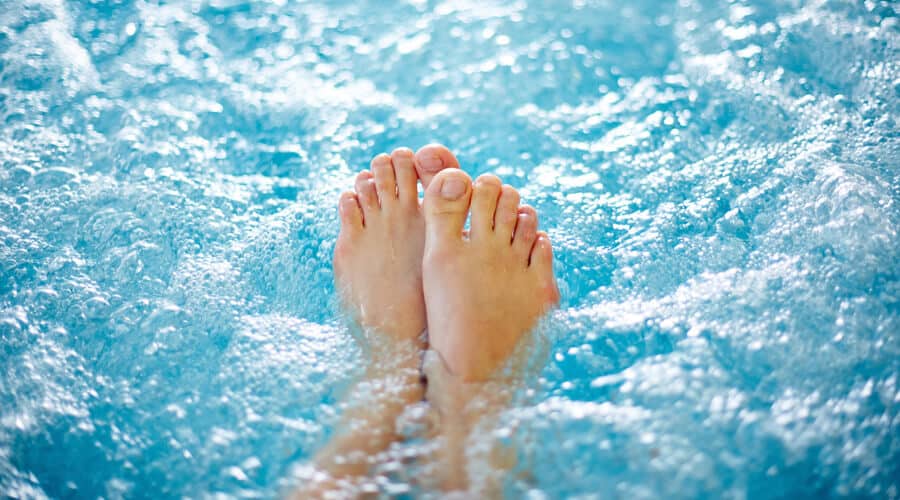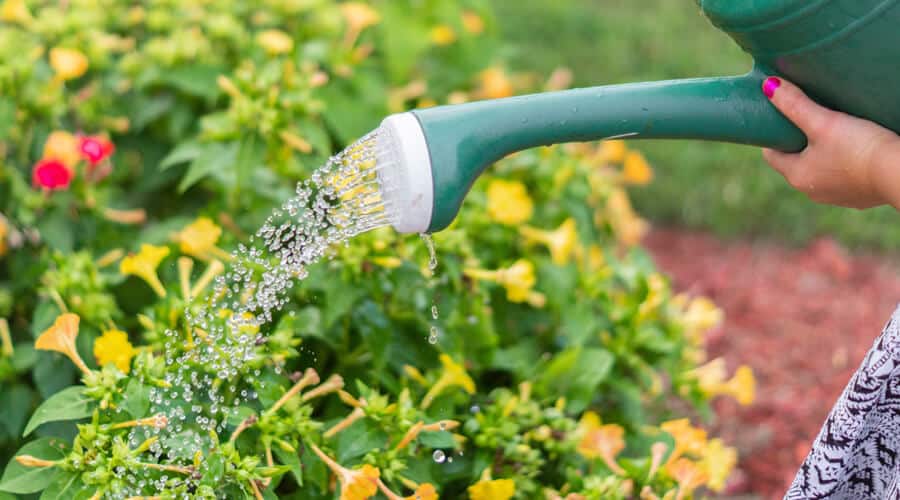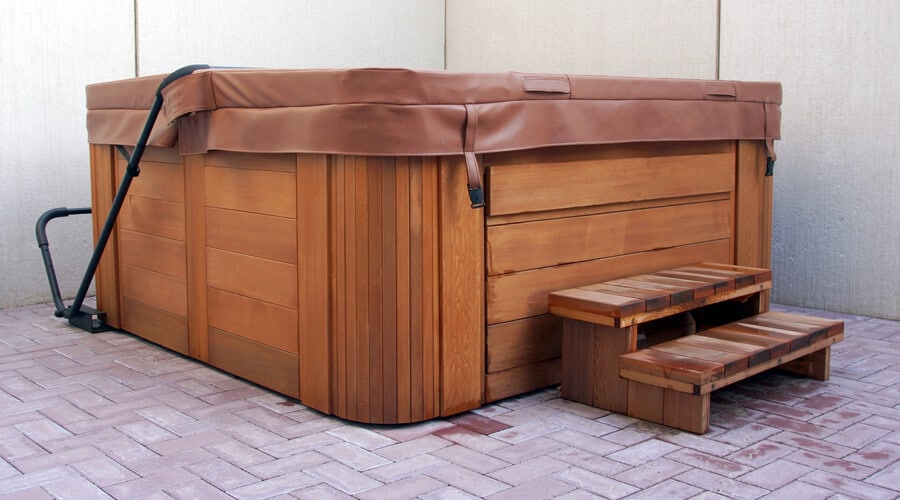For most of my adult life, I’ve been conscious of reducing my negative impact on the environment. I’ve sought ways to incorporate eco-friendly practices into my daily life. One area where I realized I could make a significant difference is in the maintenance of my hot tub. Traditional hot tubs consume a lot of energy and require harsh chemicals to keep them clean and safe. I’ve discovered several ways how to maintain an eco-friendly hot tub without sacrificing cleanliness or comfort. Read on to see how you can do the same.
My first step was to research alternative sanitization methods to reduce my reliance on harsh chemicals.
I found that there are greener options, such as using ultraviolet (UV) systems and natural enzymes, which can help keep the hot tub clean while minimizing environmental impact.
Another important aspect of maintaining eco-friendly hot tubs is optimizing energy efficiency by monitoring the water temperature and circulation schedule.
Most hot tub owners will do their part to reduce their environmental footprint by making simple, environmentally friendly changes.
So if you’re interested in maintaining a more environmentally friendly hot tub spa, try incorporating these tips into your own maintenance routine.
Why Choose to Keep a Sustainable Hot Tub
As an environmentally conscious person, I understand the importance of making careful product and lifestyle choices. That’s why I’ve decided to explore eco-friendly hot tubs.
But you don’t have to buy a special eco-friendly tub; you can make your existing traditional hot tub more eco-friendly and save you some money.
Environmental Impact
One clear advantage of choosing a greener hot tub is the reduced impact on the planet. Most hot tubs require chemicals and can consume a significant amount of energy.
Eco-friendly options like natural hot tubs use fewer resources and alternative sanitization methods and reduce chemical reliance.
Using natural enzymes and sanitization systems, eco-friendly tubs offer a greener way to keep the water clean and safe.
Additionally, using recyclable materials or more sustainable materials like wood in manufacturing ensures a smaller carbon footprint.
Some hot tubs even use solar power to reduce their reliance on fossil fuels for electricity, thus further lessening the environmental impact.
Health Benefits
Aside from the environmental advantages, I’ve noticed that sustainable hot tubs can provide health benefits too.
They often use fewer chemicals and less exposure to potentially harmful substances.
For example, some utilize ozonators to inject ozone into the water, providing an alternative to traditional chemicals.
Furthermore, lowering the temperature to around 100 degrees Fahrenheit allows me to enjoy the soothing experience without excessively heating the water and consuming more energy.
This small change reduces energy consumption and maintains the comfort level.
Many reasons exist to choose energy-efficient, eco-friendly hot tubs, including the positive environmental impact and potential health benefits.
By switching to a green alternative, I can do my part to combat climate change and reduce energy consumption while still enjoying the kind of spa relaxation that a jacuzzi provides.

Eco-friendly Hot Tub Maintenance
Water Chemistry and Balance
Maintaining a hot tub in an environmentally friendly manner starts with proper water chemistry and balance.
I test the water 2-4 times weekly to adjust pH, alkalinity, and sanitizer levels accordingly while keeping within the proper ranges.
Doing so reduces chemical use and ensures sanitized and safe water for soaking.
Instead of traditional chlorine or bromine, I use alternative sanitizers such as ultraviolet (UV) systems or biguanides.
A UV system sanitizes the water by passing it through a tube with UV bulbs, using radiation to eliminate contaminants.
I still use shock as needed to keep water clarity. Biguanides are another non-chlorine option that kills bacteria by breaking down their cell wall.
Cleaning and Inspections
Regular cleaning and inspections help avoid unnecessary chemical usage and maintain optimal performance.
I stick to a simple cleaning schedule and promote good water circulation to keep contaminants at bay.
This involves regularly inspecting the spa filter and jets for clogs, debris, or potential issues.
Addressing problems early on helps to reduce the strain on the pump, save energy costs, and keep the water cleaner.
Energy Efficiency
Regarding being more energy efficient with my hot tub, I focus on three key aspects: insulation, pump, and water capacity.
-
Insulation: A well-insulated hot tub can reduce heat loss and energy consumption. I ensure my cover is in good condition and snugly fits over the tub. This helps to insulate and retain heat, subsequently lowering energy usage.
-
Pump: Energy-efficient pumps use less energy to power water circulation and filtration. I opted for a variable-speed pump that allows me to adjust its energy usage depending on the water movement needed.
-
Water Capacity: Larger hot tubs require more energy to heat and keep the water warm. I chose a hot tub with a suitable size and water capacity appropriate for my needs. Ensuring I am not using more energy than necessary while still enjoying the relaxation and comfort it provides.
I’m mindful of the hot tub’s water capacity when filling. By using energy-efficient pumps to minimize water loss and ensure proper maintenance, I can have a green lifestyle while enjoying the benefits of my hot tub.
Lighting is another potential energy drain, LED lighting reduces the energy needed over traditional light bulbs. Overall, LEDs can use significantly less electricity.
Natural Water Sanitizers
As someone looking to maintain an eco-friendly tub, I found great ways to keep the water clean without relying on harsh chemicals like chlorine or bromine.
By using natural sanitizers such as mineral purifiers, ozonators, and ionizers, I can create a more environmentally friendly and enjoyable spa experience.
Mineral Purifiers
One of my favorite eco-sanitizing options is using mineral purifiers. This type of sanitizer contains minerals like silver and copper, which possess natural antibacterial properties.
These minerals work together to eliminate bacteria and algae in the water effectively.
When I use a mineral purifier, I also add a non chlorine shock (MPS) to eliminate organic contaminants and help oxidize chloramines, reducing the need for chemical sanitizers like harsh chlorine.
Ozonators
Ozonators produce ozone gas, a powerful natural oxidizer that breaks down organic contaminants in natural water sources, keeping it clean and clear.
By using an ozonator, I can significantly reduce the number of chemical sanitizers needed to treat my hot tub.
This benefits the environment and makes the water more gentle on my skin and eyes.
Ionizers
Lastly, I love using ionizers as a natural sanitizing solution. Ionizers release positively charged metal ions, like copper and silver, into the water.
These ions attract negatively charged bacteria and algae, binding and neutralizing them.
This natural sanitizing process keeps the water clean and safe without the harsh effects of traditional chemical sanitizers.
By using a combination of these less harsh sanitizing methods, I can confidently keep a clean and enjoyable hot tub experience without causing harm to the environment or my skin.
Alternative Water Balancing Methods
Enzyme-Based Maintenance
In my experience, enzyme-based maintenance is an excellent alternative to traditional chemicals.
Enzymes break down organic contaminants such as body oils, lotions, and other residues, allowing the filter to remove them easily.
Using enzymes reduces the need for harsh chemicals, resulting in softer, more comfortable water.
I’ve found that adding enzyme-based products weekly helps keep my water clear and reduces my maintenance time.
It’s essential, however, to ensure that you are using compatible products, as some enzyme products may not work well with certain sanitizers.
Natural pH and Alkalinity Adjusters
Balancing pH and alkalinity levels in your hot tub is crucial for maintaining water clarity and preventing equipment damage.
Instead of using harsh chemicals, I prefer natural alternatives like baking soda and alkalinity increasers.
Baking soda is a safe and effective way to increase alkalinity and pH levels in untreated water.
I use these test strips to check the pH, then I simply add the appropriate amount directly to my hot tub water, usually about 1 tablespoon per 100 gallons of water.
Alkalinity increasers can also help keep your hot tub balanced. These products work by increasing the water’s ability to resist changes in pH levels.
When added according to package instructions, they can help with proper water balance without negatively impacting the environment.
Pre-filters for Tap Water
One often overlooked step in maintaining an eco-friendly tub is addressing the quality of tap water used to fill it.
Tap water can contain phosphates, calcium hardness, and other contaminants contributing to water imbalances and potentially damaging your hot tub.
I use a pre-filter on my garden hose when filling my hot tub to combat this issue. These filters are designed to remove unwanted contaminants such as:
- Phosphates: These can cause algae growth and water cloudiness if not addressed.
- Calcium hardness: High levels can lead to scale buildup on equipment and surfaces.
- Other contaminants: Pre-filters can help remove various impurities, ensuring your hot tub water starts with a clean foundation.
These pre-filters are simple to use and play a significant role in maintaining my tub by reducing the need for additional chemicals to balance the hot tub water.
Optimizing Hot Tub Efficiency
Hot Tub Covers and Insulation
I pay special attention to the hot tub cover and insulation to promote an eco-friendly hot tub.
A high-quality spa cover is essential because it helps retain water temperature and reduces heat loss.
I always ensure the cover fits tightly and isn’t damaged, as gaps or wear and tear can reduce its effectiveness.
In addition to the hot tub cover, insulation is another key factor in keeping the water hot.
My hot tub features high-density foam filling the entire cabinet, ensuring the water remains heated without requiring extra energy.
Circulation Pumps
Efficient circulation pumps are worth considering to minimize energy consumption.
My hot tub has a circulation pump that operates continuously using low-energy modes.
This allows the water to be continuously filtered and heated, which helps maintain water balance and smooth operation.
Temperature Control
Managing the temperature of my hot tub is crucial to be energy efficient and for maximum comfort.
I’ve discovered that lowering the hot tub temperature by just a few degrees can significantly affect energy consumption.
After using it, I close the air jets, as this minimizes heat loss and keeps the water warm without overworking the heater and pump.
By focusing on these aspects, I can efficiently maintain my eco-friendly hot tub, minimize energy and water usage, and enjoy a relaxing spa experience.

Drain and Refill Best Practices
One essential aspect of maintaining an eco-friendly hot tub is draining and refilling.
As an owner, I find that using best practices conserves water and keeps the tub chemical-free and as clean as possible.
To begin, I gather all necessary equipment, including a garden hose long enough to reach from the hot tub to a drain or designated area.
For a more efficient process, I sometimes use a submersible pump which speeds up the task and reduces the water waste.
Before my hot tub is drained, I ensure good water circulation by running the jets for at least 15 minutes to loosen any debris or residue.
This helps to maintain the cleanliness of the tub when it’s refilled. To further reduce water waste, I use a simple siphon method to transfer water to my garden or lawn.
I can nourish my plants by rerouting the water this way while emptying my tub.
When refilling the tub, I pay close attention to the water source. This way, I can minimize the use of harsh chemicals often found in municipal water supplies.
By using a natural water source like collected rainwater or by installing a water filtration system, I can keep my hot tub chemical-free and maintain a more sustainable, eco-friendly environment.
Finally, I follow a regular draining and refilling schedule. Depending on the usage, I find that refilling fresh water into the hot tub every 90-100 days is ideal for keeping it as natural and eco-friendly as possible.
In conclusion, following these best practices for either an existing hot tub or a new eco-friendly one is the perfect choice to be chemical-free. I dislike the smell of chlorine, so being chemical-free is a great bonus.
I can also conserve water and be more environmentally conscious while making the most of this relaxing backyard spa retreat experience.
Frequently Asked Questions
What Are Eco-friendly Hot Tub Sanitizer Options?
In my experience, there are a few eco-friendly sanitizer options for hot tubs. One option is using biguanides, a gentle sanitizer that requires non-bromine and non-chlorine-based shock. However, some users may experience severe water conditions with biguanides, and switching back to bromine or chlorine may be a process.
Hot Tub Energy-Saving Heating Tips?
I’ve found that lowering the heat in the tub can help save energy and dramatically reduce costs. Many hot tubs are automatically set to around 104 degrees Fahrenheit, but lowering the temperature by a few degrees will not ma
Best Low-Flow Hot Tub Filtration?
Low-flow filtration systems can be an excellent way to conserve energy and water in your hot tub. However, the efficiency of a low-flow filtration system depends on factors such as the size and model of your hot tub and your maintenance habits. I recommend consulting your hot tub manufacturer for specific low-flow filtration options.
Saltwater System Benefits?
Saltwater systems can provide benefits for both the environment and the user. It eliminates the need for traditional chlorine and bromine sanitizers. Chlorine can be harsh on the skin and the environment. Additionally, saltwater systems require less maintenance since the salt cell constantly generates sanitizer, making it more convenient for the operator.
Solar-Powered Hot Tub Efficiency?
Using solar power to heat your hot tub is eco-friendly and cost-effective. Solar panels can be installed to directly heat the water, reducing or eliminating the need for electricity or natural gas. However, the efficiency of a solar-powered hot tub depends on factors like weather conditions and geographical location, so it’s essential to consider these factors before making this investment.
Wood-Fired Hot Hub Advantages?
Wood-fired hot tubs offer a unique and environmentally friendly alternative to traditional ones. In contrast to electric and gas heaters, wood-fired hot tubs use a renewable fuel source and do not require electricity. This reduces the carbon footprint and makes the hot tub more cost-effective. Moreover, the wood-fired heater can provide a charming, rustic ambiance to your soaking experience.
How To Maintain A Hot Tub Without Chemicals
Maintaining a hot tub without chemicals can be achieved through various alternative methods. One approach is utilizing a natural filtration system that relies on beneficial bacteria and enzymes to break down organic matter and maintain water cleanliness.
Regularly cleaning the filters, replacing them when necessary, and ensuring proper water circulation are crucial steps to keep the hot tub free from debris and contaminants.
Additionally, employing an ozone generator can assist in disinfecting the water without the need for chemical additives. It is also essential to regularly test the water’s pH and alkalinity levels and adjust them accordingly using natural substances such as baking soda or vinegar.
Regularly draining and refilling the hot tub, along with thoroughly cleaning its surfaces, is recommended to prevent the build-up of bacteria and maintain water clarity.
Finally, practicing good hygiene, such as showering before entering the hot tub and avoiding the use of lotions or oils, can contribute to the overall cleanliness and longevity of the hot tub without relying on traditional chemical treatments.


